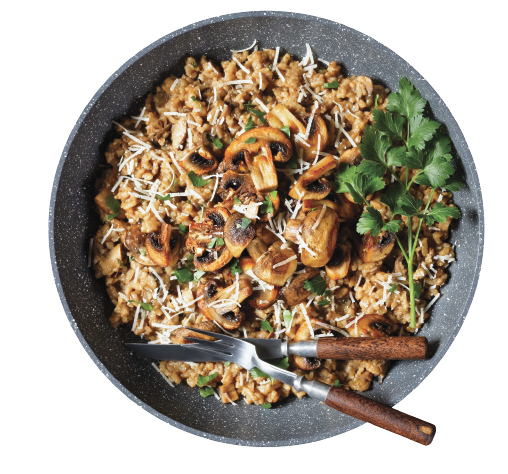In the first of a series on home chef tips and techniques, three Milwaukee-area professional chefs and restaurant owners share some secrets of the trade.
When the pandemic shutdown deprived foodies from their favorite spots to eat, many turned to takeout and home cooking to fill the void. Even as restrictions lift, more than half of participants in a national survey say they’re cooking more since the COVID-19 pandemic began.

Andy Schneider
Local Sourcing
While the easily-accessible grocery store will carry a wide selection of produce, Braise owner Dave Swanson says often that produce is evaluated for its ability to be shipped and stored versus its freshness and taste. Wisconsin is home to many local farms and farmer’s markets, and these can be great sources of fresh produce, he says. Le Rêve Patisserie & Café co-owner Andy Schneider agrees, adding that local growers at farmers markets can be a great way to find the best sources of fresh produce.
“It’s nice to just hang out and talk to people in the know,” Schneider says. “In five minutes, you’ll get a lot of information — like where to go to get your tomatoes, where you go for squash, and where to find the best onions on the market.”
And home chefs can expand their palates at farms that specialize in just one or two crops, says Egg & Flour owner (and former “Hell’s Kitchen” contestant) Adam Pawlak. “If all they do is pumpkins, squash or corn, it’s going to be the best pumpkin, squash or corn you’ve ever had,” he says.
Beyond produce, Pawlak also recommends visiting a local butcher shop for meats and seafood. If you’re using a grocery store butcher, another good alternative is to buy meats in their whole states and break them down yourself — instead of grabbing a package of boneless, skinless chicken breasts, buy a whole chicken, carve it up, and use the various cuts throughout the week, or cut your own pork chops from a pork loin.

Dave Swanson
Local Spices
Buying spices from a local spice house like Penzey’s Spices, The Spice House or Not Just Salt and Pepper can further feed a dish’s flavor, Swanson says.
While spices are dried, they shouldn’t be hard, he notes — spices that have been sitting for too long dry out, losing essential oils critical to their flavor. Finding fresh dried spices that are still soft will have the best impact.
And don’t be shy when adding dried spices to dishes. Swanson says many online recipes call for small quantities like ¼ teaspoon of a spice, but it’s likely spice quantities will need to be multiplied by six and other flavorings (garlic, shallots) by two to produce a recipe that adds more taste.
Even swapping staples such as salt and pepper can bolster a meal’s flavor, Pawlak says. Kosher salt and fresh ground pepper are much better alternatives to iodized salt and ground black pepper because their larger grains offer more control when adding them for taste, he explains.
Other fresh garnishes like fresh lemon or fresh herbs can have a big impact on the palate, Pawlak says. Local farmer’s markets can be a great place to pick up fresh herbs, he recommends — they can be stored in the kitchen lightly wrapped in a paper towel (but let them remain exposed so they stay dry).
Oil’s Well That Ends Well
Another way to add a more sophisticated, nuanced taste to a dish is by experimenting with new oils. While many recipes call for an extra virgin olive oil, extending outside of one oil flavor can provide unique variety to dishes.
In Braise cooking courses, Swanson says, oils are broken into two categories: neutral oils (such as a grapeseed oil) and oils that add flavor (olive oil, peanut oil, avocado oil or coconut oil). Understanding the role of the oil in a dish can provide creative opportunities to either enhance or alter the intended profile, he explains.
When selecting oils, there are many factors to consider, but a good place to start is testing those made in different parts of the world. Similar to wine, an oil’s flavor is largely influenced by where and how it is created. For an olive oil, start by experimenting with oils made in different countries, and don’t shy away from spending a little bit more for a quality olive oil. Swanson says grocery store olive oils may cost around 8-10 cents per ounce, but for a quality olive oil, expect to pay somewhere in the neighborhood of 30-40 cents per ounce.
“A little bit of quality olive oil goes a long way,” Swanson says. “Where you would add a cup of olive oil, you’re going to add a quarter cup, and you’ll still get the same flavor profile that that one cup of cheaper olive oil would give you.”
Farmers markets can be another great source for olive oils, he says. Getting out of the normal purchasing routine will yield the most potential.

Adam Pawlak
Get Creative
Ultimately, the best way to find the right fit in the kitchen is by experimentation. In trying new products, Pawlak encourages home chefs to make informed decisions by asking food vendors questions to learn more about the food and where it’s coming from. Likewise, Schneider encourages home chefs to engage in conversation with local growers to discover the varieties they produce and solicit additional quality recommendations.
“It’s more memorable where you can go out and see how it’s grown, see how it’s made, know where it comes from, and choose what you want,” Schneider says. “It’s just fun to cook that way.” MKE
Next issue: Professional chefs share their thoughts on must-have implements for serious home kitchen cooks.
What’s In Your Kitchen?
Three pro chefs note what they have (or what they want) in their home pantry:
“Now that we’re warming up, I want some more things that are green and look fresh rather than having root vegetables we’ve seen for the past six months.” (Dave Swanson, Braise)
“We’re friends with the owners of Brightonwoods Orchard, so we’ll go over there and they’ll tell us about the new varieties of apples they’re working with each season.” (Andy Schneider, Le Rêve Patisserie & Café)
“A box of dried pasta is always in my house at all times. You never know. It could be a snack or a meal in itself.” (Adam Pawlak, Egg & Flour)

Mushroom Risotto recipe
By Dave Swanson, Braise Restaurant
A family meal tip: Make this neutral risotto and prepare a variety of flavor and vegetable mix-ins for a build-your-own-style meal that will appeal to all tastes in the family.
Ingredients:
7 cups stock, vegetable
6 tbsp. olive oil, divided
¼ cup shallots, diced
2 tbsp. garlic, minced
½ cup white wine
¾ cup dry sherry
1 lb. Carnaroli or Arborio rice
½ lb. assorted mushrooms,
cleaned and diced
¾ cup Parmesan cheese, grated
Salt and pepper to taste
Directions:
Bring the stock to a boil. Reduce heat to a simmer.
In a sauté pan, heat three tablespoons of olive oil over high heat. Sauté mushrooms until tender. Season and set aside.
In a large saucepan, heat three tablespoons of olive oil over medium heat and add the shallots, stirring occasionally. Add the garlic and cook for 3 minutes. Stir in the rice and cook until the rice is coated with the oil. Add the wine, sherry and 2 teaspoons of salt; cook until the rice is dry.
Ladle 1 cup of simmering stock into the pan, cooking and stirring the risotto until the stock is completely absorbed. Add another cup of stock and repeat the process. After the fifth cup of stock, taste the risotto. The rice should be firm, yet cooked through. If still too firm, add some more stock. When the texture is right, it should be creamy, but not thick, rolling back after the spoon is run through the pan. Remove from heat, add the parmesan cheese and mushrooms. Season with salt and pepper.




